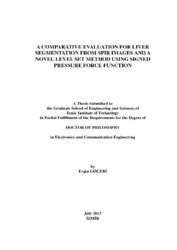Please use this identifier to cite or link to this item:
https://hdl.handle.net/11147/2946Full metadata record
| DC Field | Value | Language |
|---|---|---|
| dc.contributor.advisor | Akan, Aydın | - |
| dc.contributor.author | Göçeri, Evgin | - |
| dc.date.accessioned | 2014-07-22T13:48:39Z | - |
| dc.date.available | 2014-07-22T13:48:39Z | - |
| dc.date.issued | 2013 | - |
| dc.identifier.uri | http://hdl.handle.net/11147/2946 | - |
| dc.description | Thesis (Doctoral)--Izmir Institute of Technology, Electronics and Communication Engineering, Izmir, 2013 | en_US |
| dc.description | Includes bibliographical references (leaves: 118-135) | en_US |
| dc.description | Text in English; Abstract: Turkish and English | en_US |
| dc.description | xv, 145 leaves | en_US |
| dc.description.abstract | Developing a robust method for liver segmentation from magnetic resonance images is a challenging task due to similar intensity values between adjacent organs, geometrically complex liver structure and injection of contrast media, which causes all tissues to have different gray level values. Several artifacts of pulsation and motion, and partial volume effects also increase difficulties for automatic liver segmentation from magnetic resonance images. In this thesis, we present an overview about liver segmentation methods in magnetic resonance images and show comparative results of seven different liver segmentation approaches chosen from deterministic (K-means based), probabilistic (Gaussian model based), supervised neural network (multilayer perceptron based) and deformable model based (level set) segmentation methods. The results of qualitative and quantitative analysis using sensitivity, specificity and accuracy metrics show that the multilayer perceptron based approach and a level set based approach which uses a distance regularization term and signed pressure force function are reasonable methods for liver segmentation from spectral pre-saturation inversion recovery images. However, the multilayer perceptron based segmentation method requires a higher computational cost. The distance regularization term based automatic level set method is very sensitive to chosen variance of Gaussian function. Our proposed level set based method that uses a novel signed pressure force function, which can control the direction and velocity of the evolving active contour, is faster and solves several problems of other applied methods such as sensitivity to initial contour or variance parameter of the Gaussian kernel in edge stopping functions without using any regularization term. | en_US |
| dc.language.iso | en | en_US |
| dc.publisher | Izmir Institute of Technology | en_US |
| dc.rights | info:eu-repo/semantics/openAccess | en_US |
| dc.subject.lcsh | Diagnostic imaging--Digital techniques | en |
| dc.subject.lcsh | Magnetic resonance imaging | en |
| dc.subject.lcsh | Level set methods | en |
| dc.title | A Comparative Evaluation for Liver Segmentation From Spir Images and a Novel Level Set Method Using Signed Pressure Force Function | en_US |
| dc.type | Doctoral Thesis | en_US |
| dc.institutionauthor | Göçeri, Evgin | - |
| dc.department | Thesis (Doctoral)--İzmir Institute of Technology, Electrical and Electronics Engineering | en_US |
| dc.relation.publicationcategory | Tez | en_US |
| dc.identifier.wosquality | N/A | - |
| dc.identifier.scopusquality | N/A | - |
| item.openairecristype | http://purl.org/coar/resource_type/c_18cf | - |
| item.languageiso639-1 | en | - |
| item.openairetype | Doctoral Thesis | - |
| item.grantfulltext | open | - |
| item.fulltext | With Fulltext | - |
| item.cerifentitytype | Publications | - |
| crisitem.author.dept | 03.05. Department of Electrical and Electronics Engineering | - |
| Appears in Collections: | Phd Degree / Doktora | |
Files in This Item:
| File | Description | Size | Format | |
|---|---|---|---|---|
| T001097.pdf | DoctoralThesis | 3.72 MB | Adobe PDF |  View/Open |
CORE Recommender
Page view(s)
248
checked on Mar 31, 2025
Download(s)
144
checked on Mar 31, 2025
Google ScholarTM
Check
Items in GCRIS Repository are protected by copyright, with all rights reserved, unless otherwise indicated.